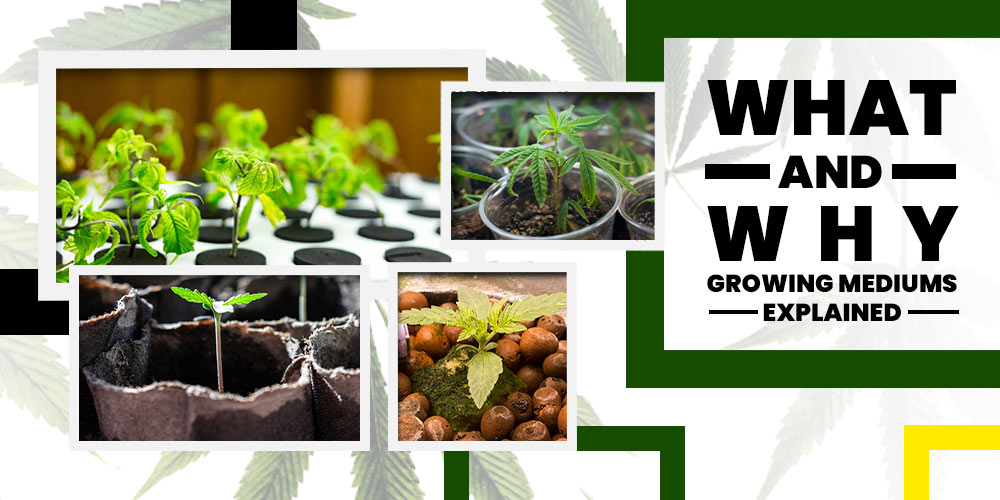



What is the ideal growing medium and style for cultivating marijuana? Would hydroponics, soil, or a hybrid like a coco coir or other soilless mixes produce the highest yields and the finest buds? This guide offers insights into each cannabis growing medium, including its advantages and disadvantages, ease of use, impact on crop yields, and bud quality. Whether you’re a novice or an experienced grower, this tutorial can help you decide which approach is right for you and get you started growing cannabis immediately.
Growing cannabis in soil is a popular choice for many beginners. Suppose you have experience growing other plants in soil or maintaining a soil garden. In that case, this option may be the best fit for you because you already know what’s needed to grow cannabis in soil.
Pros and Cons of Growing in Soil
Pros
Growing cannabis in the soil can be a straightforward option, especially for those who already have gardening experience, as it is similar to growing other plants such as tomatoes or corn. Hand-watering plants in containers is a simple way to manage soil-grown cannabis.
For outdoor growers, using soil is often the preferred method since cannabis naturally grows in soil in the wild. Soil-based outdoor growing is intuitive and easy. Using composted “super soil” for outdoor cannabis cultivation eliminates the need for synthetic bottled nutrients or pH management, making it an ideal choice for those who want a hands-off approach.
There are two options for soil-based cannabis cultivation: Option 1 is to purchase soil from a store and add nutrients throughout the growth to produce healthy cannabis plants. Option 2 involves amending and composting your own “super soil” specifically for cannabis plants or buying already composted super soil. While this option may require more time upfront, it can be simpler for those who have previously composted soil. Note that some growers believe that using organic composted super soil with a rich microbial life can enhance the taste and aroma of cannabis by boosting the production of terpenes and terpenoids.
One of the downsides of soil-based cannabis growing is that soil may contain pests, requiring more maintenance and attention than other grow mediums like hydroponics.
Cons
Soil-based cannabis cultivation has a few drawbacks. One is that soil can contain various pests that can harm plants, making soil growers more susceptible to pest attacks than hydroponic growers.
Another disadvantage of soil-based growing is that it takes longer than soilless or hydroponic setups. In general, hydroponic plants grow faster, especially during the vegetative stage, producing better growth rates than in soil.
Regarding setup costs, soil-based cannabis cultivation is relatively affordable. All you need is soil and a container. Fox Farms Happy Frog and Fox Farms Ocean Forest are common soil mixes used for cannabis, but any high-quality organic soil mix will work. However, avoiding using Miracle-Gro soil or anything with “extended-release” nutrients is important. Adding 30% perlite and 10% vermiculite if the soil seems heavy can help aerate and loosen it. Composting your super soil is a proven option that can yield some of the best results. Common containers include classic plastic pots, terra cotta pots, smart pots (fabric pots), and air pots. Standard gardening pots are best for soil mixes with perlite added to ensure adequate aeration for the cannabis roots. Smart pots and air-pots provide additional air to the root zones from the sides and don’t require much (if any) extra aeration or perlite in soil mixes.
Regarding setup effort, soil-based growing requires relatively little effort compared to other methods, except for growing cannabis in a soilless mix. The main effort will likely be in selecting the appropriate soil and nutrients.
The cost of soil growing can be relatively low after setup, with the main cost being replacing the soil every growth. Reused soil may only produce good results if you know how to amend it with the necessary nutrients. In addition, occasional container replacements may be required if they crack or break.
Maintenance effort for soil growing involves watering your plants, providing nutrients as needed, and managing the pH of the root zone if you’re not growing in composted super soil. Soil grows tend to have slower growth rates than hydroponic methods, but impressive growth rates can still be achieved with a great environment and ample light. The vegetative stage usually lasts 1-3 months, while the flowering/budding stage can last 2-3 months, depending on the strain. Some growers believe that cannabis grown in organic super soil has the best taste and smell profile, though this is a topic of debate among hydroponic growers.
It is important for growers to remain close by for their first grow, especially for inexperienced growers. While experienced growers can safely spend more time away from their garden, checking on plants at least once a day is best. Since constant watering is unnecessary, bigger containers hold more water, giving growers more time away from their gardens. However, unexpected events such as pest infestations or falling plants can happen anytime, so it is always best to be vigilant.
When people think of hydroponics, they usually envision a water reservoir as the growing medium, although technically, any growing medium other than soil is considered hydroponics, including soilless mediums such as coco coir. To differentiate solution culture hydroponics from other hydroponics, solution culture refers to any type of hydroponics with no inert medium.
This section focuses on hydroponic systems where the cannabis roots grow directly in water and/or the grower is required to maintain a water reservoir. In the next section, we will discuss soilless mediums, which are technically a type of hydroponics but are more commonly viewed as similar to growing in soil.
Pros and Cons of Growing in Hydroponics
Pros
Hydroponic growing offers several advantages over other growing methods. Firstly, it provides faster vegetative growth than any other method, leading to earlier harvests. Secondly, experienced hydroponic growers can usually achieve bigger yields than experienced soil growers, provided they have the same conditions, such as light and nutrients.
Another advantage of hydroponic growing is that it is less likely to be attacked by pests. This is because many pests require soil as part of their lifecycle, and soil is absent in hydroponic setups. Although it is still possible to introduce pests into a hydroponic grow room, it is less likely compared to soil-based grows. Additionally, some hydroponic methods are relatively low maintenance, and some growers believe that some options are as simple as growing in soil.
Cons
Hydroponic setups typically require a higher initial investment than other growing methods and may require some DIY work. Nutrient management can be difficult for hydro growers, especially when using a variety of supplements from different companies, so following a proven nutrient formula is crucial. Although hydro growers have complete control over nutrients, problems should be addressed quickly. Root problems can be challenging for hydro growers, but there are steps to ensure healthy roots, such as providing adequate oxygen and maintaining water temperatures around 70°F (20°C).
Some hydro methods are high maintenance and require frequent monitoring for optimal growth rates. Additionally, hydroponic growing outdoors can be challenging due to the difficulty of controlling essential variables such as the sterile environment, temperature, and pump power.
DWC (Deep Water Culture): This hydroponic system involves suspending plants in a nutrient-rich water solution with air stones providing oxygen to the roots. This is a simple yet effective system that is popular among beginners.
Top-Fed DWC (Bubbleponics): This system is a variation of DWC where the plants are suspended in a water solution, and water is fed to the top of the container through a drip line or spray nozzle. This provides the roots with both oxygen and water and is known to promote faster growth rates.
NFT (Nutrient Film Technique): In this system, a thin film of nutrient-rich water flows through a slanted tray or tube, and plants are placed in small net cups to allow their roots to dangle the water. This system requires a constant flow of nutrient solution to maintain plant growth.
Ebb & Flow (Flood & Drain): This hydroponic system involves flooding the growing container with a nutrient solution for a set period and draining it back into a reservoir. This system promotes better nutrient uptake and growth rates, but it requires a timer and a drainage system.
Aquaponics (Fish for Nutrients): This system combines hydroponics with aquaculture, where fish are grown in a tank, and their waste is used to fertilize plants grown hydroponically. The plants, in turn, help to purify the water, creating a sustainable closed-loop system.
Aeroponics (Misted Air): In this system, plants are suspended in the air, and their roots are misted with a nutrient-rich solution. This allows for optimal oxygenation and nutrient uptake by the roots, promoting faster growth rates and bigger yields.
Drip System (Automatic Watering): This hydroponic system involves dripping nutrient solution onto the base of each plant through a drip line or tubing. This system is relatively simple and requires minimal maintenance.
Hand-Watered Hydro (Soil-Hydro Fusion): This system is a fusion of soil and hydroponics, where plants are grown in soil, but water and nutrients are supplied via a hydroponic system. This provides the benefits of both growing methods, such as better control over nutrient uptake and faster growth rates. However, it requires careful management of watering and nutrient levels.
Hydroponic setups can vary in cost, depending on the system’s complexity. DIY systems can be inexpensive if you are willing to build them yourself, and parts are readily available at hardware stores. Kits with all necessary parts are also available and can be comparable in price to building it yourself. Setting up a hydroponic system can require effort, so it is important to do your homework and find a proven setup to copy for your first grow. Some setups that use a timer may require tinkering to get everything to work properly, while aquaponics requires additional time and effort to set up a tank that can support fish.
Hydroponic maintenance costs mainly go towards nutrients and grow lights, with occasional replacement of tubing, pumps, and air stones. First-time growers need to invest more effort in maintenance, but experienced growers can maintain a hydroponic setup in as little as half an hour a week. Hydroponic setups generally promote faster vegetative growth, but genetics still determine the duration of flowering/budding. The amount of time a grower can be away from their hydroponic garden depends on the setup, with larger reservoirs allowing for more time away and highly tuned setups requiring more constant checking. Checking on plants at least once a day is recommended to avoid unexpected events.
Growing cannabis using soilless mediums like coco coir, perlite, vermiculite, or rock wool is becoming increasingly popular among indoor growers. Soilless mediums provide a clean, consistent, and highly customizable growing environment, allowing growers to control nutrient delivery, water uptake, and aeration to the roots. Coco coir, in particular, has gained widespread popularity due to its high water retention capacity, neutral pH, and low EC levels, making it an excellent choice for hydroponic and soilless systems. Whether you are a seasoned grower or a beginner, learning about the benefits and drawbacks of different soilless mediums is crucial for optimizing your yield and growing healthy cannabis plants.
Pros and Cons of Growing Soilless
Pros
Growing cannabis in soilless mediums such as coco coir have become increasingly popular among growers due to its advantages over traditional soil growing methods. One of the biggest advantages is faster vegetative growth. In addition, soilless growing mediums are less likely to attract pests and are generally easier to manage. With hand-watering methods, growing in a soilless medium requires about the same effort as growing in soil. In this way, soilless mediums offer a convenient and efficient option for cannabis growers.
Cons
Compared to the soil, soilless mediums can provide faster growth rates for cannabis plants, although not as fast as full hydroponic setups with optimal oxygen supply. However, finding the right nutrient balance for soilless mediums can be challenging for some growers, especially when using various company nutrients and supplement products. Following a proven cannabis nutrient formula specific to the chosen growing medium can help address this challenge.
Soilless growing mediums, such as coco coir, are popular for growing cannabis due to their faster vegetative growth and reduced pest issues. However, they require a specific mix of inert components to achieve proper aeration and water-holding properties, which can be challenging for inexperienced growers. One recommended soilless mix for cannabis includes 30% perlite and 10% vermiculite added to hydrated coco coir bricks. Common containers include classic plastic pots, terra cotta pots, smart pots, and air pots, each allowing for different potting mix densities. While setup effort is minimal for soilless setups, choosing the right mix and nutrients can take some research, as soil-based nutrients are unsuitable for soilless growing.
Soilless growing offers a number of benefits and considerations to take into account. The main cost involved is replacing the potting mix each grows, as reusing old potting mixes can result in a buildup of nutrient salts that are difficult to rinse out properly. Additionally, used containers may need to be replaced from time to time. Maintenance efforts include watering the plants, adding nutrients, and managing the pH of the root zone, which is especially important when growing in a soilless mix to ensure nutrients are readily available to the plant roots. Soilless mixes generally have faster growth rates than growing in soil, especially when provided with a great environment and ample light. For inexperienced growers, remaining close to the garden for the first grow is important. In contrast, experienced growers can safely spend more time away, especially using larger containers holding more water. Nevertheless, checking on the plants at least once a day is always advisable to prevent nutrient deficiencies, plants falling over, or other unexpected events that may require attention.



Best Selling
Feminized Seeds
Regular Seeds
Customer Help
Contact Us
WE SELL MARIJUANA SEEDS IN THE USA

Are You 18 Or Over?
YesOr
No By clicking yes, you certify that you are over 18. By using this website, you agree to our legal disclaimer.